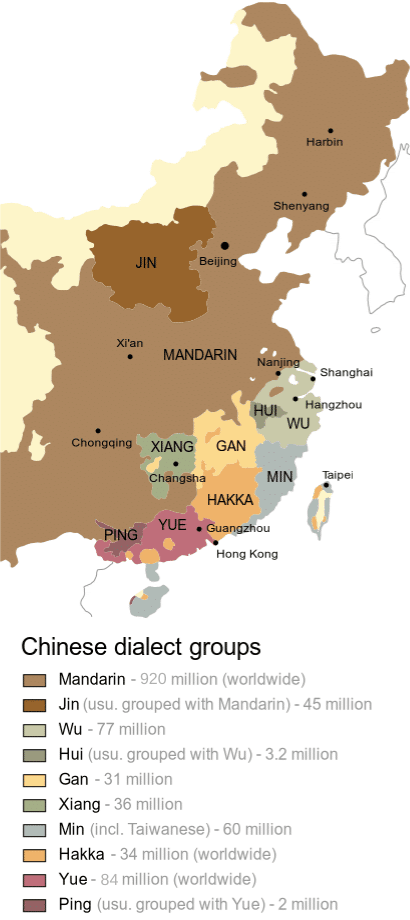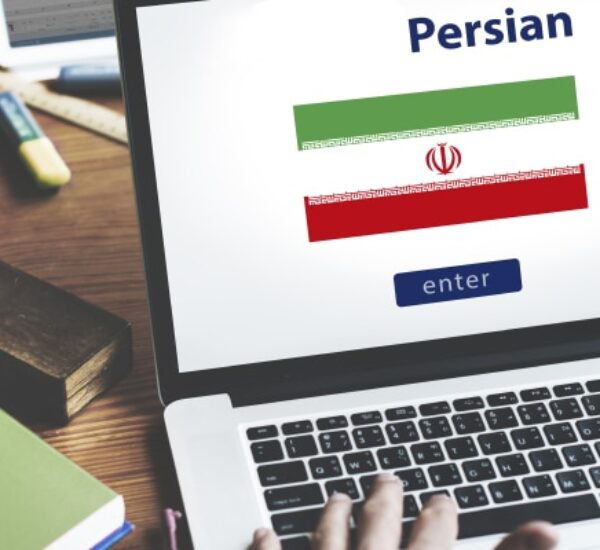Recently updated on January 11th, 2024 at 08:17 pm
Providing professional Chinese dialect transcription services with accuracy and affordability can be a complex task. For those who are unfamiliar with the Chinese language, it’s often unclear what languages are spoken in China. It’s commonly believed Chinese is spoken in China. As a matter of fact, Chinese isn’t really a language. What people really mean is Mandarin. But do you know that Mandarin isn’t the only dialect in China? In fact, a huge percentage of Chinese people can’t even speak Mandarin.
In this article, we’ll review:
Table of Contents
- Facts About the Chinese Language Family
- What Are the Challenges of Chinese Dialect Transcription Services?
- Chinese Dialect Transcription Services by Chinese Copywriter
- Frequently Asked Questions
Facts About the Chinese Language Family
China is a vast country with a long, complicated history, and this complexity is reflected in the stunning level of linguistic diversity still present in the country today. China consists of 31 provinces, municipalities, and autonomous regions, and each has its own regional dialect. The variations between dialects are so pronounced due to China’s unique topographical features. Some regions are divided by ribbons of mountain ranges and mighty rivers.
China also has a history that stretches back to more than 5,000 years. Thus, it’s only expected that a region as large and old as China would develop such unique linguistic varieties. China has hundreds of ethnic groups and populations living in the hinterland region and each has their own way of speaking.
How Many Chinese Dialects Are There?
There are several hundred languages in China. The predominant language is Standard Chinese, which is based on central Mandarin, but there are hundreds of related Chinese languages, collectively known as Hanyu (simplified Chinese: 汉语; traditional Chinese: 漢語; pinyin: Hànyǔ, ‘Han language’), that is spoken by 92% of the population.
The languages of China can be divided into two different categories.
Mandarin and Other Chinese Variants
The first category includes Mandarin Chinese, which belongs to the Sino-Tibetan language family and is the most commonly spoken language in China.
In addition, it also includes languages which are considered variants of Chinese, such as Cantonese. These are often referred to as dialects, even though they are often mutually unintelligible.
There are 10 main Chinese varieties.
- Standard Mandarin
- Min Chinese
- Wu Chinese
- Cantonese (Yue)
- Jin Chinese
- Gan Chinese
- Hakka (Kejia) Chinese
- Xiang Chinese
- Huizhou Chinese
- Pinghua Chinese and other unclassified dialects

Minority Languages
There are many other notable languages spoken in China including Mongolian, Tibetan, Uyghur, Zhuang, Bai, Gyalrongic languages, and Miao-Yao languages.
The Uyghur language, 维吾尔语 (wéi wú ěr yǔ), is the most popular of these inside China, with over 10 million speakers.
There are 10 main minority languages.
- The Tai-Kadai (Kra-Dai) language family
- The Hmong-Mien language family
- The Austroasiatic (Mon-Khmer) language family
- The Turkic language family
- The Mongolic language family
- The Tungusic language family
- The Koreanic language family
- The Indo-European language family
- The Austronesian language family
- The Sino-Tibetan language family
What Are the Challenges of Chinese Dialect Transcription Services?
Linguistic Diversity
Dialects are official variations of a language. For example, American English, British English, and Australian English are their own dialects. The confusion here is that the variation between dialects is either subtle to very extreme and the term dialect often gets thrown around a lot and misused.
Since we’re in the context of Chinese dialects, the variation between Chinese dialects isn’t exactly modest in comparison to the modest differences between American English and British English. Sure, they speak in different accents and use certain vocabulary & phrases in a different way, but they can definitely still understand each other. When it comes to Chinese dialects, you’ll be exposed to a whole new level of linguistic diversity. You’ll be surprised to know that these dialects can be quite far off from each other. To the point that speakers from each dialect won’t be able to understand each other almost completely.
Many Chinese dialects are different from each other, which should classify them as separate languages. However, for now, they are almost universally described as dialects, which poses great challenges especially in Chinese transcription services.
Addressing Cultural Nuances
Transcription involves far more than exchanging words from one language to another. Computer transcriptions exist, but no software can take cultural nuance into consideration. Linguists often face idioms, colloquialisms, and the like. The transcriptionist should be fluent in both languages to avoid a cultural faux pas. At Chinese Copywriter, we solve that problem for you.
Our linguists have all the skills required for accurate transcription. They are familiar with various Chinese dialects and Mandarin accents, including Cantonese, Min, Hakka, etc. They also have excellent listening comprehension skills. Your business dealings are too sensitive to take chances with transcription and translation. Let Chinese Copywriter handle these aspects of your commerce. You can then focus on doing what it takes to make your business successful.
Chinese Dialect Transcription Services by Chinese Copywriter
Chinese Copywriter offers professional Chinese dialect transcription services to businesses and private individuals for all types of audio and video content. We completely understand the importance of accuracy in transcription. That’s why we always aim for 99% accuracy. Our Chinese dialect transcribers have no less than 5 years of Mandarin transcription experience, so you can be sure your audio files are transcribed with great care and attention to detail.
Native Chinese Dialect Transcribers
It’s vital to be a native speaker when transcribing Chinese dialect as languages have a lot of intricacies understandable only to native people. At Chinese Copywriter all the Chinese dialect transcription services are provided by native speakers. For instance, if your market research interviews are carried out in Chengdu and the speech features strong accents, we would only assign transcribers who are Chengdu natives to complete the transcription. If your market research interviews are carried out in Guangzhou and the speakers speak Cantonese, we would assign native Cantonese speakers either from Hong Kong or Guangzhou to provide Cantonese transcription services.
Extra Layer of Proofreading
At Chinese Copywriter, we offer free of charge proofreading on our Chinese dialect transcription services because we believe that when a client entrusts us with a project, they expect it to be done perfectly.
Each recording is transcribed by an experienced transcriptionist and proofread by a second linguist for accuracy and completeness. For an additional charge, we can insert time codes into the transcript. We can also translate the transcript if required.
Eliminating Inaudibles
At Chinese Copywriter, we make it our responsibility to eliminate inaudible by re-listening to all parts of the audio which are unclear, and we certainly don’t give up easily. However, if we have tried everything, including slowing down the audio, researching on Google, and using software to remove the background noise, we will unfortunately need to use the dreaded timestamp tag to let the client know that it requires special attention.
The main factors which may cause us to use timestamping include overlapping speakers, low-speaking voices, accents, dialects, background noise, and poor-quality recording.
Share your transcription needs with us. We will get back to you with an exact quote for our Chinese dialect transcription services in under 30 minutes.
Frequently Asked Questions
What are the oldest languages in the world?
Here’re the 10 oldest languages in the world:
1. Egyptian – 2690 BC (circa. 4700 years old)
2. Sanskrit – 1500 BC (circa. 3500 years old)
3. Greek – 1450 BC (circa. 3500 years old)
4. Chinese – 1250 BC (circa. 3300 years old)
5. Aramaic – 1100 BC (circa. 3100 years old)
6. Hebrew – 1000 BC (circa. 3000 years old)
7. Farsi – 522 BC (circa. 2500 years old)
8. Tamil – 300 BC (circa. 2300 years old)
9. Korean – no later than 57 BC – Present (circa. 2100 years old)
10. Italian (as descendent of Latin) – 100 BC (circa. 2100 years old)
What are the 10 most difficult languages in the world?
Here’re the 10 hardest languages in the world:
1. Mandarin
2. Arabic
3. Japanese
4. Hungarian
5. Korean
6. Finnish
7. Basque
8. Navajo
9. Icelandic
10. Polish
What’s the hardest language to learn?
Mandarin Chinese is the hardest language to learn.
How many languages are spoken in China?
Officially, there are 302 living languages in China. Depending on your definition of “language” and “dialect,” this number can vary.
Are Mandarin and Chinese the same?
Mandarin is a dialect of the Chinese language.
Are Chinese dialect transcription services able to transcribe spoken or written dialects?
Chinese dialect transcription services can transcribe both spoken and written dialects. For spoken dialects, the transcription service will take an audio recording of the dialect and transcribe it into texts. For written dialects, the transcription service may transcribe written text from one dialect into standard Chinese. Some transcription services may also offer translation services, which can convert the transcribed text into another language.
Can Chinese dialect transcription services provide translations in addition to transcriptions?
Yes, some Chinese dialect transcription services can provide translations in addition to transcriptions. In this case, the transcription service will first transcribe the dialect into texts, and then provide a translation of the transcribed text into another language.
Are Chinese dialect transcription services available for both individual and business clients?
Yes, Chinese dialect transcription services can be useful for individuals or organizations that need to transcribe or translate dialects for a variety of purposes, such as academic research, legal proceedings, business communications, or personal use.
Can Chinese dialect transcription services handle audio or video recordings with multiple speakers?
Yes, many Chinese dialect transcription services are able to handle audio or video recordings with multiple speakers. These services typically use advanced technology and trained native transcriptionists to transcribe the spoken dialect, taking into account the different voices and accents of the speakers.

Translation Manager
Eva has 6 years of experience working as a News Editor and 5 years as a freelance copywriter. She holds a bachelor’s degree in English from the Guangdong University of Foreign Studies and a master’s degree in applied Linguistics from the University of Melbourne.



